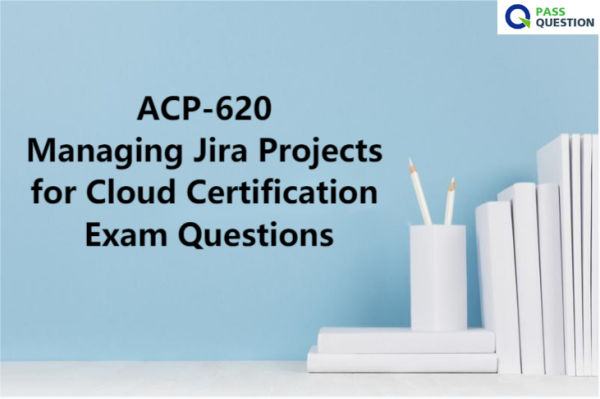ACP-620 Managing Jira Projects for Cloud Certification Exam Questions
ACP-620 Exam preparation is necessary in order to clear the Managing Jira Cloud Projects test. PassQuestion ACP-620 Managing Jira Projects for Cloud Certification Exam Questions are designed on the pattern of real exams that will definitely help you to pass the Atlassian ACP-620 exam on the first attempt. You must ensure that you are taking ACP-620 practice test questions many times so you can be sure of your performance in the real test. PassQuestion provides the best ACP-620 Managing Jira Projects for Cloud Certification Exam Questions so you can definitely clear exams on the first attempt. It gives an original pattern and method to appear in the actual ACP-620 exam.

Managing Jira Projects for Cloud (ACP-620)
ACP Certification in Managing Jira Projects for Cloud covers the skills needed to configure and automate Jira Software's Scrum and Kanban templates. Managing Jira Projects for Cloud is intended for anyone who wants to upgrade themselves in Jira Cloud. This exam covers the knowledge of users who use Jira Cloud as Project Administrators. Before appearing for tougher exams such as ACP-120, it is recommended to test your skills on ACP-620.
Exam Details
Number of Questions: Up to 75 questions
Passing Score: 63%
Duration: 180 minutes (3 hours)
Cost: USD $100
Exam Objectives
Project Creation (10-15% of exam)
- Given a scenario, recommend a project implementation (company-managed, team-managed, project templates, shared configuration)
- Create and configure team-managed projects (access, issue types, fields, project features)
- Given business requirements, recommend an issue type configuration for a company-managed project
- Describe how to manage general project configurations (project details, project sidebar)
Board Configuration (25-35% of exam)
- Given a scenario, recommend an appropriate board type (Scrum, Kanban, Kanban with backlog)
- Given business requirements, configure boards across multiple teams and projects
- Configure board columns to match a workflow process
- Translate requirements into board filters, sub-filters, and quick filters
- Determine the effects of estimation and time tracking on Scrum boards
- Configure board swimlanes, card colors, card layout, working days, and issue detail view
- Troubleshoot board and filter configurations
Managing Projects (25-35% of exam)
- Determine appropriate permissions for project team members (project, global)
- Assign team members to project roles
- Implement versioning, manage releases, predict the impact of scope changes
- Recommend a method to sub-categorize issues (components, labels, custom fields)
- Configure and troubleshoot automatic issue assignment (project default, components)
- Configure issue field layout
- Evaluate ways to enrich issues (attachments, links, time tracking, developer information)
Automation (15-20% of exam)
- Identify ways to automate Jira (bulk change, workflow, automation, apps)
- Create an automation rule based on business requirements
- Troubleshoot Jira automation
Reporting (15-20% of exam)
- Translate business requirements into appropriate JQL queries
- Determine an appropriate gadget and dashboard configuration
- Analyze information from agile reports and issue analysis reports
- Recognize how Jira can facilitate agile at scale
View Online Managing Jira Cloud Projects ACP-620 Free Questions
1. Which of the following are suitable scenarios to use Jira group? (Choose four.)
A. The project administrator will manage group membership.
B. Members of the group are responsible for making bulk changes on multiple issues.
C. Same users will be working on multiple projects.
D. The site administrator will manage group membership.
E. Permission can be managed at the global level.
F. Team members require 'Work On Issues' permission to log work done.
Answer: B, C, D, E
2. Which of the following are true about sub-tasks? (Choose three.)
A. Sub-tasks can be disabled.
B. Sub-tasks can have sub-tasks.
C. Users cannot move sub-tasks to another project.
D. Sub-tasks can be translated into other installed languages.
E. Users cannot convert sub-tasks to epics.
F. Users can convert sub-tasks to standard issue types, and vice versa.
Answer: A, D, F
3. Sarah created a new custom field called 'Project Cost'. She cannot view the field in some of the issues.
Which of the following is true?
A. Some issues have 'Issue Level Security' applied.
B. 'Project Cost' value is empty.
C. 'Project Cost' is one of the 'Hidden fields'.
D. She needs 'Browse Projects' permission.
Answer: B
4. Which of the following are true aboutthe Jira permission? (Choose three.)
A. You need 'Resolve Issues' permission to reopen resolved issues.
B. You need 'Manage Sprints' permission to complete your sprint.
C. You need the Jira Core application access to create a new sprint.
D. You need 'Resolve Issues' permission to set the 'Fix version' field.
E. You need 'Fix Version' permission to set the 'Fix version' field.
F. You need 'Move Issues' permission to move the issue's status to another status
Answer: A, B, D
5. Which of the following are true about creating a Jira board? (Choose three.)
A. We cannot create a new board while creating a new Jira project.
B. We can create a new board for only one Jira project.
C. We cannot create a new board from someone else's saved filter.
D. We can create a new board formultiple Jira projects.
E. We can create a new board from our own saved filter.
F. We can create a new board from the existing project.
Answer: D, E, F
- TOP 50 Exam Questions
-
Exam
All copyrights reserved 2025 PassQuestion NETWORK CO.,LIMITED. All Rights Reserved.

